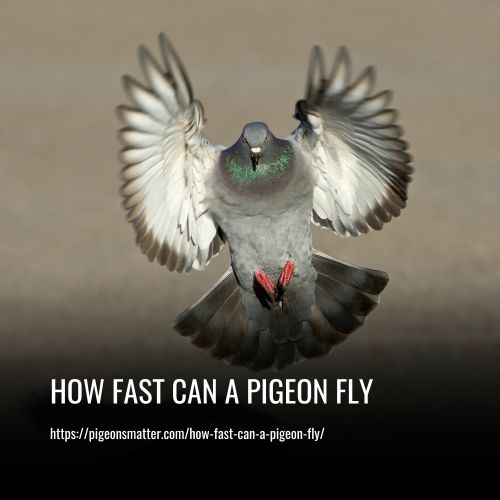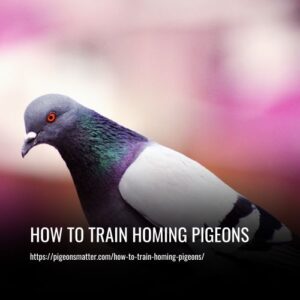Pigeons are known for their impressive flying abilities, especially their speed. With their powerful wings and breast muscles, they can fly up to 90 miles per hour, making them one of the fastest birds in the world. When flying together, groups of birds can save energy and increase their speed by drafting off of each other.
Their speed is put to the test in racing events, where they compete in short, medium, or long-distance races. Pigeons are capable of flying long distances without stopping, thanks to their strong wings and breast muscles that allow them to glide for extended periods of time. During extended flights, breaks for rest and meals are taken, but typically they are capable of flying for hours without stopping.
The world record for the longest distance flown by a pigeon is over 7,000 miles, completed in just under 10 days, highlighting their impressive endurance. Overall, pigeons are truly remarkable birds that showcase incredible speed and stamina in the skies.

How Fast Do A Racing Pigeons Fly
Racing pigeons have been specifically bred and trained to reach far higher speeds than their wild counterparts. While the maximum speed of most pigeons is around 70 mph, racing pigeons have reached an impressive 93 miles per hour in recent years. This can enable them to cover distances between 450 and 700 kilometers in a single day.
However, care must be taken when raising these special birds for competition, as the intense training regimens used could put stress on the birds, leading to health issues or decreased performance.
Measuring The Speed Of A Pigeon
Measuring the speed of a pigeon is a precise process that involves the use of sensors. Pigeons are released and fly past a sensing device, which records their time using their RFI ring. The recorded data is then analyzed by a computer to calculate their exact speeds. This method ensures accurate measurements and is commonly used in pigeon racing competitions.
Is A Pigeon Faster Than A Falcon?
While pigeons are relatively fast birds, they are no match for the speed of falcons. Pigeons typically fly at speeds ranging from 77.6 to 92.5 miles per hour, while Peregrine Falcons are capable of reaching speeds of up to 186 miles per hour. It should be noted that both of these birds are faster than the average bird, which typically flies at speeds between 19 to 37 miles per hour.
Peregrine Falcons are renowned for their impressive speed and are considered one of the fastest-flying birds in the world. Many factors contribute to a bird’s speed, including environmental and geographical conditions, as well as the bird’s health, weight, and ability. While pigeons are relatively fast, they can’t compete with the lightning-fast speed of a Peregrine Falcon.
Why Do Pigeons Fly Faster?
Pigeons are known for their impressive flying speed, which is attributed to their stamina and muscle flexibility. The flying speed of pigeons is influenced by various factors, including their environment, cellular structure, and overall health. Racing pigeons, for instance, is capable of flying at a remarkable speed of 92 miles per hour.
To prepare for races, pigeons are given a special diet and exercise regimen to increase their strength and flexibility. This extended feeding time and exercise routine provide them with the necessary fuel and physical abilities required to compete. By training their bodies to perform at a higher level, racing pigeons are able to achieve incredible speeds and endurance in flight.
The Fastest Pigeon Species
There are multiple pigeon species to consider when looking for the fastest, specifically those utilized for racing. Some of the fastest pigeon species include the Belgian Postal Pigeon, English Quarry Pigeon, Moscow Monk Pigeon, Tape Turman Pigeon, Damask Pigeon, Tula Hot Turman Pigeon, Kalot Pigeon, and German Elster Pigeon.
Certain species, including the Belgian Postal Pigeon, are often sought after for competitive purposes. These racing pigeons are trained extensively and provided with proper nutrition to enable them to fly long distances. As a result, they can be sold at high prices in the market.
How Fast Do Pigeons Fly Compared To Other Pigeons?
When comparing pigeon velocities, it’s crucial to consider several variables. Age is a significant factor, with young pigeons being faster due to their higher energy levels and fewer age-related issues.
Pigeon species and individual birds also have varying flying speeds, with some breeds bred for specific tasks and capable of higher speeds than others. The Racing Homer is an example of a breed specifically bred for speed and efficiency.
Pigeon velocities can range from 40-70 miles per hour for some species to as high as 90 miles per hour for others. Understanding these variables is essential to accurately compare pigeon velocities.
How Fast Do Pigeons Fly Compared To Other Birds?
Pigeons are impressive birds that possess both speed and agility.
1. Speed
Several pigeon species can reportedly reach speeds of up to 70 mph, which is quite impressive. However, this speed is only achieved while flying straight and does not indicate their agility.
2. Agility
Pigeons are incredibly agile birds that can fly in tight circles and perform acrobatics. Their large wing area allows them to quickly shift direction to avoid obstacles, making them one of the most maneuverable birds. This agility is essential for navigating urban environments where buildings and other structures can pose a challenge.
The Flying Speed Of Pigeons Compared To Other Birds
| Type of Birds | Highest Speed | Unit |
|---|---|---|
| Peregrine falcon | 241.71 | Miles Per hour |
| Golden eagle | 149.12-198.83 | Miles Per hour |
| White-throated needletail | 105.01 | Miles Per hour |
| Eurasian hobby | 99.41 | Miles Per hour |
| Frigatebird | 95.06 | Miles Per hour |
| Spur-winged goose | 88.23 | Miles Per hour |
| Red-breasted merganser | 80.15 | Miles Per hour |
| Rock dove (pigeon) | 92.52 | Miles Per hour |
| Grey-headed albatross | 78.91 | Miles Per hour |
| Anna’s hummingbird | 61.06 | Miles Per hour |
How Can Pigeons Travel Long Distances?
The anatomy of pigeons is a crucial factor in their ability to undertake long-distance flights. With their powerful wings and muscular legs, they are well-suited for extended travel. Their wing design also helps them maintain a steady flight, making it easier for them to cover long distances.
Pigeons possess both physical and mental abilities that allow for extended flights without losing strength, making the species well-suited for long-distance travel as messengers. Whether delivering messages or racing across vast distances, pigeons are capable of undertaking incredible feats of endurance and skill.
Training a Pigeon to Increase Flight Speed
To help your Pigeon fly faster, it’s important to focus on building its stamina and strength through exercise. Outdoor flights and practicing different speeds and directions can help your Pigeon develop its flying abilities.
In addition to exercise, special diets and supplements can also aid in your Pigeon’s overall health and development. Amino acid supplements, in particular, can help your Pigeon reach its full potential.
Establishing goals, providing proper nutrition, and being patient are all key factors in training your Pigeon to fly faster. With consistency and dedication, your Pigeon can reach new heights in its flying abilities.
Factors Affecting The Speed Of Pigeons
Pigeon speed can be influenced by size, age, sex, and surroundings. Younger and smaller pigeons tend to be faster, while older and larger ones tend to be slower. Obstructions such as trees and buildings, as well as temperature, air pressure, and wind, can also affect how fast a pigeon can fly. Variations in temperature and air pressure can have an impact on the flight of pigeons.
Higher temperatures and air pressures can cause a pigeon to fly slower, while cooler temperatures and lower air pressures can make it fly faster. Wind can also have a significant impact on a pigeon’s speed, with some winds providing a speed boost of up to 15%. However, obstructions like trees and buildings can reduce a pigeon’s velocity as it tries to avoid them.
Pigeons’ flight speed can be affected by the density of the air and the strength of the wind. They tend to fly faster in warm and dry conditions with less dense air and weaker wind, while colder and wetter conditions with thicker air and stronger wind can slow them down.
Finally, a pigeon’s size can also affect its speed, with larger pigeons generally being faster due to their more aerodynamic wings. As a pigeon owner or enthusiast, it’s important to understand these factors to ensure the well-being and optimal performance of your feathered friend.
Pigeons Can Fly Fast-the Theory
Pigeons have been used for centuries to carry messages, with their agility and precision proving crucial to military efforts such as in World War II. Currently, these birds continue to be used for communication and competitive activities.
Racer pigeons have been recorded reaching speeds of up to 93 miles per hour, making them one of the fastest bird species globally. Their quickness and accuracy make them ideal for racing and other competitive events.
FAQs
Pigeons have been known to fly up to 600 to 700 miles in a day and can fly without stopping for up to 13 hours. The longest distance a pigeon has flown on record is 7,200 miles, and it took approximately 24 days to accomplish.
Pigeons are a diurnal species that typically do not fly at night due to their limited night-time vision. They differ from nocturnal animals like owls and generally sleep at night while being active during the day. Pigeons typically find a place to rest at night, such as building windows, trees, rooftops, and other structures.
Pigeons possess the ability to travel for more than 1,100 miles without becoming disoriented. Species such as homing pigeons are renowned for their instinctual navigation, as evidenced by their historic use as messengers. Pigeons have a strong sense of direction and memory, which makes it unlikely for them to become lost when far away from their home.
Studies have shown that pigeons are capable of flying long distances up to 1,100 miles (1770 KM) during races.
Pigeons are able to achieve high speeds due to their light body weight, efficient respiratory and digestive systems, and their ability to utilize thermals for quick ascension. These adaptations give them a faster flying ability than many other bird species.
Conclusion
While pigeons may not be the fastest birds in the sky, they are still impressive creatures that have been revered and utilized by humans for centuries. Whether you’re a bird enthusiast or just curious about the world around you, understanding the capabilities of these feathered friends is a fascinating topic to explore.
So next time you see a pigeon, take a moment to appreciate their unique abilities and the important role they play in our ecosystem.


